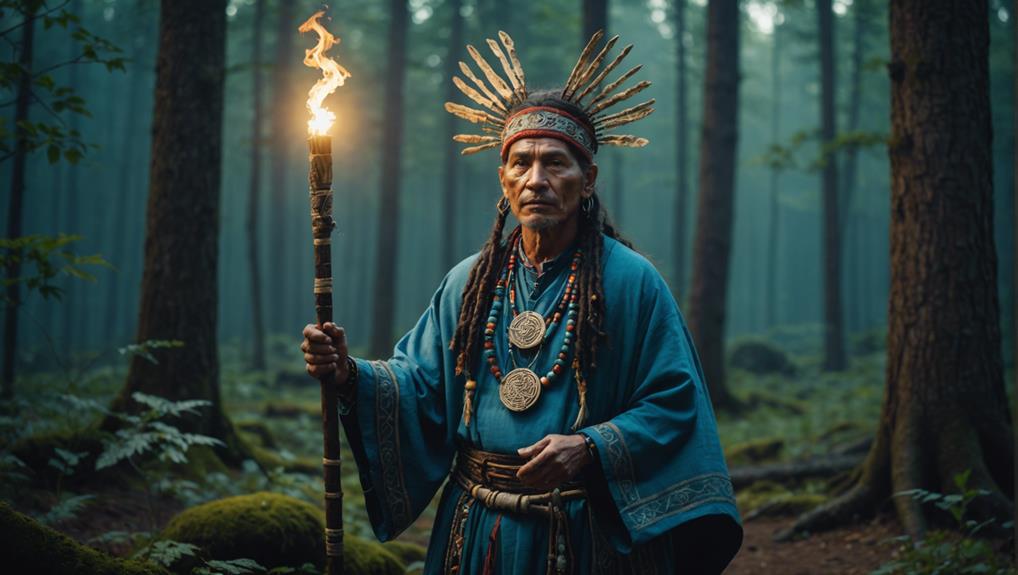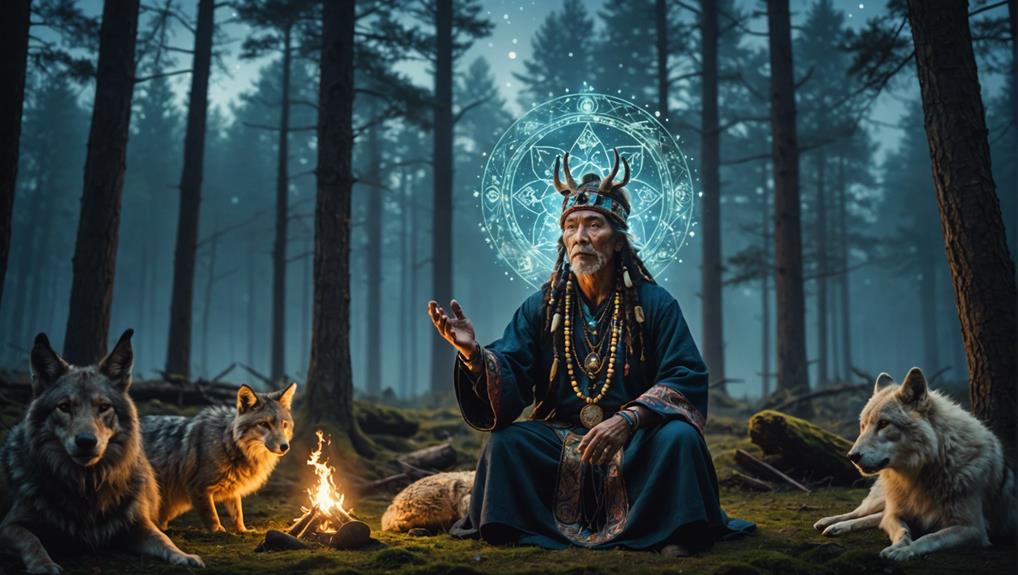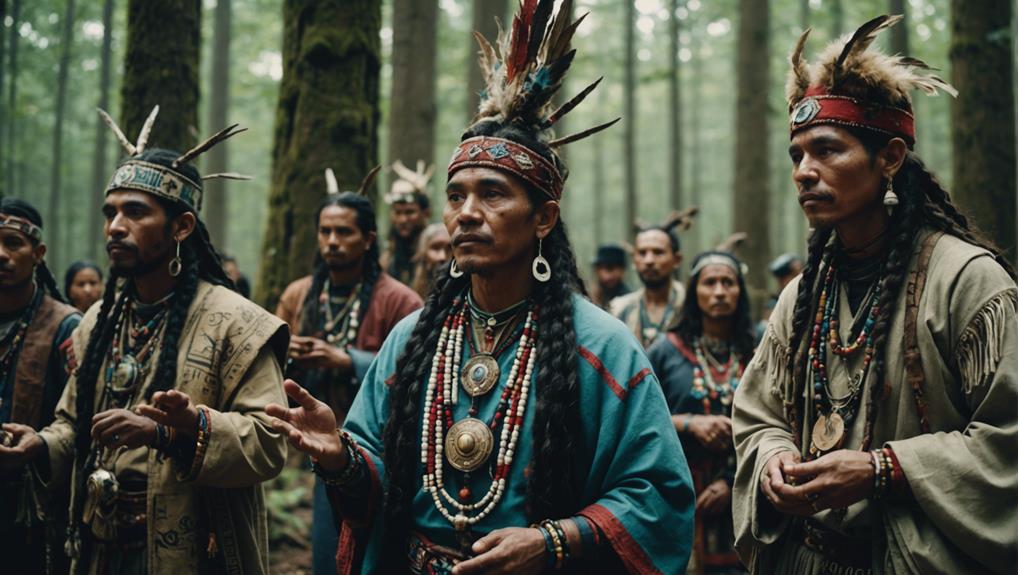Summary
Shamanism connects you with the spirit world to guide and heal you. Shamans, acting as healers and guides, use rituals involving drums, rattles and feathers. Healing practices include energy work and herbal remedies aimed at restoring balance. These methods integrate ancient traditions into modern life for transformative experiences. Originating thousands of years ago, shamanism deeply respects nature and holistic health. Traditions around the world, from the rituals of Siberia to the ayahuasca ceremonies of South America, showcase its diverse practices. As you delve deeper, you will discover detailed practices and global variations in shamanic traditions.
Key Points
- Shamanism involves connecting with the spirit world through rituals to gain guidance and healing.
- Shamans use tools such as drums and feathers and techniques such as traveling and soul recovery.
- Healing practices include energy cleansing, soul retrieval and herbal remedies.
- Shamanism has ancient roots and can be found in cultures all over the world, from Siberia to Native America.
- Shamans lead community rituals, offer spiritual guidance and teach ancient practices for balance and harmony.
What is shamanism?

Shamanism is an ancient spiritual practice in which shamans connect with nature, spirits and ancestors for healing and guidance. It has roots in various cultures around the world, including indigenous communities in the Americas, Africa, Asia and Europe. Key features include rituals, trance-like states and working with spiritual guides to restore balance and harmony.
Definition of shamanism
At its core, shamanism involves connecting with the spirit world to seek guidance and healing. This Ancient spiritual practice uses shamanic rituals to establish spiritual connections with various dimensions. Shamans serve as healers, mediators and guides, often traveling in altered states of consciousness to communicate with spiritual allies, animals, plants and elements. These journeys are central to the healing practices of shamanism, aiming to restore balance and well-being.
A key aspect of shamanism is its emphasis on the interconnectedness of all beings. The Shamans understand that true healing and wisdom come from recognizing and honoring these relationships. By participating in shamanic rituals, they draw on the wisdom of the natural world and the spiritual plane, seeking insights and solutions that promote harmony.
Living in harmony with nature is another important principle of shamanism. Shamans believe that by aligning with the rhythms and cycles of the natural world, they can foster a deeper sense of balance and peace. This holistic approach to healing and guidance emphasizes the importance of maintaining spiritual connections and respecting the interconnectedness of all life forms.
Origins and history of shamanism
Going back to its roots of tens of thousands of years, the practice of shamanism has been woven into the fabric of countless ancient cultures around the world. From the steppes of Siberia to the rainforests of the Amazon, shamanic rituals have been instrumental in shaping spiritual and communal life.
In these ancient practices, shamans often acted as spiritual leaders, leading their communities through various rites and ceremonies. They acted as intermediaries between the physical and spiritual worlds, using their deep connection with nature to facilitate mystical healing and gain insights. This connection was not merely symbolic; it was an essential part of their worldview, deeply rooted in their daily lives.
Through the use of shamanic rituals such as drumming, singing and dancing, these spiritual leaders entered into altered states of consciousness. Through such states, they communicated with spirits and obtained guidances for healing and problem solving. The wisdom they gained from these experiences helped them deal with physical, emotional and spiritual ailments within their communities.
Le timeless techniques and beliefs of shamanism reflect a deep respect for nature and a'holistic approach to health and spirituality. By understanding its origins, it is possible to appreciate the lasting bond and the universal principles that continue to influence the modern practices.
Key characteristics of shamanism
Basically, one shaman connects with the spiritual world to heal and guide their community. This spiritual connection forms the core of shamanism, enabling practitioners to access insights and energies beyond the physical domain. I shamanic rituals play an essential role in this process, often involving singing, drumming or dancing to enter into a trance state.
Shamans use a variety of shamanic tools, such as drums, rattles and feathers, which help them focus their energy and intention. . Each ceremony is designed to address specific needs, whether they are physical healing, emotional release or spiritual guidance.
Healing practices in shamanism are diverse, encompassing energy work, herbal remedies and the extraction of negative energies. The shaman acts as a mediator, channeling healing energies from the spiritual world to the patient. In this way, he helps to restoring the balance and harmony in the individual and the community.
Shamanism teaches the integration of these ancient practices into modern life, offering transformative experiences. Through the shamanic practices, you can deepen your connection with nature and the spiritual world, promoting personal and community well-being.
The role of the shaman
As a shaman, you are a spiritual leader and healer, acting as a bridge between the physical and spiritual worlds. Your role includes. Lead the community through shamanic rituals and practices. Help others reconnect with lost wisdoms and foster the personal growth.
Spiritual leader and healer
A shaman plays an essential role as a connection between the physical and spiritual worlds, offering guidance and healing to those in need. As a spiritual leader, a shaman performs various healing rituals aimed at restoring balance and well-being. These rituals often involve the energy cleaning, a process in which negative energies are removed to promote physical and emotional health.
The Shamans also provide spiritual guidance, helping people navigate life's challenges through insights gained from the spiritual world. One of their key practices is soul retrieval, a method used to recover lost parts of a person's soul that may have become fragmented due to trauma. This process is vital to the emotional healing And overall harmony.
In addition to individual healing, shamans play a significant role in community healing. They bring people together, fostering a sense of collective unity and well-being. By addressing the spiritual and emotional needs of the community, shamans help maintain social harmony.
Their wisdom and skills are passed down from generation to generation, making them custodians of ancient knowledge. Whether you are seeking personal healing or community balance, the shaman's role as a spiritual leader and healer is indispensable in bridging the gap between the physical and spiritual worlds.
Communicating with the spirit world
To communicate with the spirit world, you will find shamans using techniques such as drumming, singing and dancing to achieve altered states of consciousness. They may also use enteogens and sacred plants to further deepen their spiritual connections. These practices allow shamans to access guidance, protection and wisdom from the spirit realm.
Techniques for achieving altered states of consciousness
The Shamans use techniques such as drumming, song, dance and herbal medicines to enter altered states of consciousness and connect with the spirit world. You may encounter:
- Breathing techniques
- Sound care
- Meditation practices
- Methods of display
- Ritual ceremonies
These methods help shamans connect the physical and spiritual domains, offering healing and guidance by tapping into unseen energies and wisdom.
Drumming, singing and dancing
Drumming, sing, and dancing are essential tools that enable shamans to Of communicating with the spirit world. Healing rhythms and mantra sacred generate energy, creating a sacred space. Trance dance acts as a moving meditation, fostering a spiritual connection and grounding with the Earth. These practices help shamans enter trance states, enabling them to receive spiritual guidance and insights.
Use of enteogens and sacred plants
While drumming, singing and dancing create a sacred atmosphere, the use of enteogens such as ayahuasca, peyote and psilocybin mushrooms opens deeper channels for spiritual communication and healing. These medicinal plants offer:
- Deep healing properties
- Deep spiritual insights
- Transformative enteogene experiences
- Essential roles in shamanic rituals
- Safe use through shamanic training
Such practices have been fundamental in all cultures and historical periods.
Leading the community
As a shaman, you lead ceremonies and rituals that foster community cohesion and spiritual connection. Your wisdom and guidance help people navigate life's challenges and find balance. Teaching shamanic practices, you enable others to integrate these ancient traditions into their daily lives.
Conducting ceremonies and rituals
Shamans lead their communities through deep ceremonies and rituals, acting as essential conduits between the spiritual and physical worlds. You will find them deeply involved in:
- Ritual preparation, ceremonial practices
- Creation of sacred spaces, energy purification
- Use of singing techniques, drum
- Connection with ancestral connections, spiritual allies
- Guiding healing rituals, transformative experiences
Their work provides balance and harmony within the community.
Offering wisdom and guidance
A shaman's orientation is crucial in guiding the community through the spiritual and physical challenges they encounter. They offer wisdom teachings, spiritual guidance and healing rituals. Their intuitive insights and sacred wisdom help maintain balance and harmony. Shamans act as intermediaries between worlds to provide solutions to challenges.
| Wisdom teachings | Spiritual orientation | Healing rituals |
|---|---|---|
| Sacred wisdom | Intuitive insights | Energy work |
| Shamanic journey | Spiritual allies | Divination |
| Balance | Harmony | Wellness |
| Ancient wisdom | Community support | Rites |
Shamanic worldview

In shamanism, you will find a belief in the interconnectedness of all beings and the spiritual essence in everything. This worldview includes the concept of a spiritual dimension, where shamans connect with guides and energies for healing. By understanding this, you can appreciate how shamans act as mediators between our world and the invisible dimensions.
Concept of the spirit world
In shamanism, you will find that the spiritual world is seen as a complex web of different domains and dimensions. Nature spirits, ancestors and guides inhabit these spaces, each playing a unique role in influencing the physical world. Shamans work within this interconnected system, acting as a bridge to healing and wisdom.
Different realms and sizes
The core belief of shamanism is that there are many worlds and dimensions beyond our physical world. You can investigate:
- Parallel universes In which different versions of reality coexist.
- Astral projection To travel between these planes.
- Multidimensional beings Who inhabit these spaces.
- Spiritual dimensions Who hold wisdom and healing.
- Alternative realities accessible through rituals.
These plans offer deep insights and connections.
Nature spirits, ancestors and guides
Connecting with the nature spirits, ancestors and guides is central to the shamanic practice. Nature spirits offer healing, while the ancestors' guides provide wisdom. The spirit animals help you make a deeper connection with the world. Through the shamanic journeys, you gain insights into the spirit world. Communicating with guides through rituals is essential to gain guidance and understanding on your shamanic path.
Interconnectedness of all things
In shamanism, you will find a deep belief in the interconnected network of life, where everything is interdependent. Maintaining balance and harmony within this network is essential for the shamanic practice. This worldview will shape rituals, healing practices and spiritual journeys aimed at harmonizing the relationship between human beings, nature and the spiritual domain.
Belief in the web of life
The belief in the interconnectedness of all things lies at the heart of shamanism, which sees every element of nature as part of a unified whole. It is observed:
- Interconnection of nature
- Spiritual unity
- Balance and harmony
- An interdependent network
- Universal interconnection
Shamanism teaches that everything from the smallest plant to the largest animal is interconnected and interdependent, forming a harmonious web of life.
Importance of maintaining balance and harmony
Maintaining balance and harmony is fundamental in shamanism, reflecting the belief that all elements of the universe are interconnected. Achieving inner balance and restoring harmony are essential for energetic alignment and spiritual balance. The Shamanic practices focus on healing of connection, emphasizing the interdependence between human beings, nature and the cosmos. By maintaining this balance, practitioners believe they can promote overall well-being.
Shamanic Practices and Techniques
When you dive into the shamanic practices, you will encounter techniques such as the shamanic journey and the soul recovery, which aim to heal and guide. These practices also include healing rituals and methods of divination and prophecy. Together, they form the core of the shamanic tradition, helping you connect with ancient wisdom and spiritual insights.
Journey and soul recovery
In shamanic practices, traveling in the spirit world allows you to recover lost parts of your soul, a process essential for healing and balance. By connecting with spiritual allies, you can deal with emotional and spiritual wounds. Understanding this technique is vital to restoring your wholeness.
Purpose and process of the shamanic journey
The shamanic journey allows you to access spiritual dimensions to receive guidance and healing by entering an altered state of consciousness. It offers:
- Healing journeys
- Spiritual Connections
- Soul Guide
- Altered consciousness
- Spiritual insights
Through drumming, chanting or visualization, you connect with spiritual guides and power animals. This process fosters personal growth, self-discovery and deep healing, addressing spiritual imbalances and enriching your life path.
Recovery of lost soul parts
Many shamanic practitioners believe that the soul recovery can help restore parts of the soul lost to the trauma. This technique aims to heal the trauma by recovering these lost fragments, promoting spiritual integration and inner wholeness. Through the journey, often supported by drumming or chanting, practitioners work toward emotional balance, helping you achieve a more complete sense of well-being and spiritual growth.
Healing practices
In exploring the shamanic healing practices, you will encounter techniques such as negative energy extraction, power animal recovery and soul restoration. These methods aim to remove blockages, restore spiritual power and repair fragmented parts of the soul. Integrating these practices can lead to profound healing and transformation.
Extraction of negative energies
Extracting negative energies involves removing harmful influences to restore balance and promote healing. Techniques include:
- Power Cleaning To purify your aura.
- Soul recovery To reclaim the lost parts of your spirit.
- Cord cutting To break toxic connections.
- Rites and songs To invoke healing energies.
- Sacred instruments and allies To help in the purification process.
These methods restore harmony and energy.
Guide animal recovery
Just as the extraction of negative energies restores balance, the recovery of the spiritual animal puts you in touch with animals spiritists to guide and protect you. Through the techniques of shamanic journey and meditation on the powerful animal, you can connect with spiritual guides. Spiritual animal symbolism reveals qualities to embody and provides messages from animal spirits. This practice draws on the wisdom and energy of your powerful animals for healing and strength.
Restoration of the soul
The restoration of the soul exploits ancient Shamanic techniques to heal and reintegrate fragmented parts of your spirit. You will engage in:
- Soul recovery To regain lost parts of yourself
- Healing Crystals To balance your energy
- Power Cleaning To remove negative influences
- Spiritual allies for guidance and support
- Shamanic chanting To connect with deeper dimensions
These practices offer deep healing and spiritual renewal.
Divination and prophecy
In shamanism, you seek guidance by reading signs, symbols and omens. Communicating with spirits offers insights and clarity about life's challenges. These practices provide a deeper connection with the unseen worlds for personal growth and decision making.
Reading the signs and omens
The interpretation of signs and omens in shamanism involves interpreting symbols and natural elements to gain spiritual insights and guidance. You will use:
- Interpretation of symbols for spiritual guidance
- Natural elements to capture intuitive insights
- Readings from the tarot And animal spirits for divination
- Various divination tools to foster a shamanic connection
- Analysis of omens to decode spiritual messages
These practices enrich your connection with the spiritual domain.
Communicating with spirits to receive directions
Shamans communicate with spirits for guidance using techniques such as journeying, meditation and trance states. Communication with spirits involves ethical considerations, respecting spiritual boundaries. When seeking guidance, they interpret signs and trust intuitive guidance, often connecting with ancestors to honor their spiritual lineage. By trusting intuition, shamans access divine messages, ensuring that the guidance they receive is meaningful and respectful of spiritual laws.
Shamanism around the world

You will find the shamanism in many cultures, from Siberia and Central Asia to Native American and South American traditions. African shamanism also offers unique practices and perspectives. Each region brings its own flavor to this ancient spiritual practice.
Siberian and Central Asian shamanism
In Siberian and Central Asian shamanism, the Tengrism plays a key role, emphasizing the importance of the worship of heaven and the interconnectedness of all beings. Shamans are often seen adorned with distinctive clothing and the use of specialized tools such as drums and ritualistic objects. These elements are essential for entering into trance states And perform their sacred duties.
Tengrism and the role of the shaman
Rooted in the ancient traditions of Central Asia and Siberia, Tengrism centers around the celestial deity Tengri and the vital role of shamans as intermediaries between the physical and spiritual domains. You will find:
- Shamanic rites
- Spiritual healing
- Connecting with nature
- Reverence toward the deity Tengri
- Shamanic ceremonies
Shamans maintain balance and harmony, reflecting a deep reverence for nature and heavenly forces.
Distinctive clothing and tools
Shamanic clothing and tools in Siberian and Central Asian traditions embody a deep connection with both nature and the spirit world. Clothes symbolic such as animal skins and feathers, and spiritual objects such as drums and rattles, are essential. Clothes Shamanic and ritual tools. play a significant role in ceremonies.
| Symbolic clothes | Ceremonial tools | Shamanic regalia |
|---|---|---|
| Animal skins | Drums | Feathers |
| Feathers | Rattles | Symbolic jewelry |
| Inspired by nature | Ceremonial objects | Sacred implementations |
Native American Shamanism
Ceremonies such as the Sun Dance (Sun Dance) and the Vision Quest (Vision Quest) play key roles in spiritual and cultural life. These rituals, unique to each tribe, reflect their distinct traditions and beliefs.
Diversity of practices among different tribes
Native American shamanism varies widely among tribes, each with its own unique rituals and beliefs. You will find:
- Navajo healing ceremonies: focus on restoring balance.
- Hopi Spiritual Guides: they connect with the ancestors.
- Lakota purification rites: they purify the spirit.
- Tepidari: they clean and regenerate.
- Medicine wheels: They symbolize the interconnectedness of life.
These tribal variations highlight the ritual diversity and cultural differences within shamanic traditions.
Sun Dance and Vision Quest ceremonies.
Two of the most profound ceremonies in Native American shamanism are the Sun Dance and the Vision Quest. The Sun Dance has ritual significance for spiritual transformation and healing practices. The Vision Quest involves solitary reflection and connection with nature, guiding individuals through personal revelations. Both ceremonies emphasize the importance of community and respect for nature, fostering a deep spiritual growth And ancestral wisdom.
South American shamanism
In South America, you will find shamanic traditions deeply connected to the land and its powerful medicinal plants. The Amazon is renowned for ceremonies of ayahuasca, while the Andes have their own unique practices and deities. Both regions highlight the role of the shaman As a healer and spiritual guide.
Ayahuasca and the shamanic tradition of the Amazon.
Ayahuasca, a powerful medicinal drink, is central to the Amazonian shamanic tradition, fostering deep connections with nature and the spiritual dimension. This shamanic drink offers:
- Deep experiences with medicinal plants
- Healing rites ceremonials
- Deep spiritual insights
- Sessions led by experienced shamans
- Embrace of the amazonian spirituality
It is a transformative path that invites you to investigate the interconnectedness of all living things.
Andean shamanic practices and deities.
Andean shamanic practices often connect deeply with nature, spiritual entities and the cosmos to promote healing and balance. You will come across offerings to the Pachamama, which honor Mother Earth, and in ceremonies dedicated to the Sun Inti. Apus rituals invoke mountain spirits to obtain guidance. These practices emphasize Andean healing and shamanic balance, using sacred plants and rituals to connect the physical and spiritual domains.
African Shamanism
In various African cultures, the shamans play important roles as healers and spiritual guides. They use music, dance and trance of possession to connect with the spirit world and carry out their tasks. These practices reflect their deep connection with nature and the spiritual domain.
Role of shamans in various African cultures
Shamans in various African cultures frequently act as healers, spiritual guides and mediators between the physical and spiritual worlds. They perform:
- Healing rituals
- Community ceremonies
- Ancestral connections
- Spiritual guidance
- Shamanic traditions
These practices aim to bring balance and harmony by addressing physical, emotional and spiritual needs within the community. Each shaman's role reflects the unique cultural and spiritual beliefs of their tribe.
Use of music, dance and trance of possession
Deepening their roles as healers and spiritual guides, African shamans make extensive use of music, dance and trance of possession to connect with the spiritual realm. Healing rhythms and trance of possession in shamanic rituals facilitate spiritual connection. Music in the shamanic ceremonies guide transformation through dance, enabling shamans to communicate with spirits. This fusion enhances both healing and spiritual practices.
